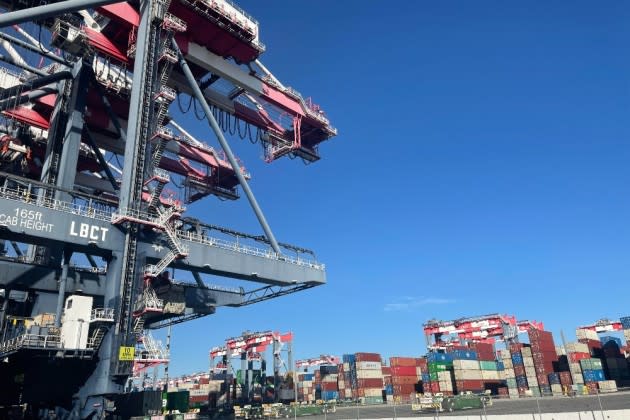West Coast Port Tensions Lead to Walk Out

Click here to read the full article.
Operations at the Ports of Long Beach and Los Angeles ground to a halt Thursday, with International Longshore and Warehouse Union (ILWU) crane operators and top handler drivers rejecting their second shift assignments for the evening.
The 5 p.m. walk-off resulted in the overnight closure of terminals across both gateways, and work remained stalled on Friday with no indication of when it would resume.
Protracted and largely unproductive labor negotiations at the West Coast ports have led to disruptions across the retail supply chain, according to National Retail Federation (NRF) senior vice president David French. The trade group has reiterated its concerns about the situation to the White House amid the current standoff.
“It is essential that the ongoing labor negotiations between the International Longshore and Warehouse Union and the Pacific Maritime Association (PMA) are resolved immediately,” he said. “We again call on the administration to engage and prevent any further disruption to port operations and cargo fluidity.”
Retail businesses have become collateral damage in a dispute that has dragged on for more than eight months since the labor contract expired last July. “Retailers throughout the country depend on U.S. ports to support their daily business needs,” French said, and the West Coast ports, “especially those in Los Angeles and Long Beach, are a pivotal entry point to the United States that allow American consumers access to global products and essential goods.” NRF has reported that shippers have shifted cargo to other gateways as anxieties about the situation persist.
In March, NRF took the lead in crafting a letter to President Joe Biden, calling up on his administration to push for a speedy resolution to the labor feud. Signed by 238 state, local and federal trade associations, the missive urged the Commander in Chief to help push for a new ILWU-PMA agreement. Tensions rose later in the month as employers alleged that dockworkers were slowing the handling of cargo at the ports by taking their lunch breaks at the same time.
A resolution can’t come soon enough, as activity at the ports stands to ramp up over the coming months. The group’s Global Port Tracker data, developed with Hackett Associates, indicated this week that cargo volume at container ports across the U.S. “should climb steadily” throughout the summer, after dropping to a three-year low in February.
“Last spring and summer were the busiest ever as consumers spent freely and retailers brought in merchandise to meet demand,” NRF vice president for supply chain and customs policy Jonathan Gold said. “This year won’t repeat that, but the numbers we’re expecting would have been considered normal before the pandemic.”
“The priority at the moment is resolving labor negotiations at the West Coast ports and avoiding any self-inflicted supply chain challenges on top of those we’ve faced the past three years,” Gold added.
Compared with 2022, “the flow of import containers on the West Coast continues to decline along with demand as carriers increasingly drop service to Los Angeles-area ports,” according to Hackett Associates founder Ben Hackett. Carriers are stretching out voyages and hitting other ports to help absorb excess capacity, he said. “Meanwhile, freight rates have been impacted by the fall in demand, but new ships are starting to show up and more have been ordered—a sign that carriers expect demand will improve by the time the new vessels are delivered.”
February saw a more than 25-percent year-over-year decline in TEU volume, nearly sinking to the historic low seen in early 2020. Global Port Tracker insights revealed that U.S. ports handled 1.55 million TEU during the month, a 14.4-percent decline from January, and the lowest figure since May 2020, when just 1.53 million TEU passed through American ports.
U.S. gateways haven’t yet reported March numbers, but Global Port Tracker projected that the month will see a year-over-year drop of more than 28 percent to 1.68 million TEU. Numbers will likely begin to climb in April, with 1.86 million TEU forecasted—18 percent less than the same period a year prior. May is expected to see 1.91 million TEU, down 20.1 percent year over year, and June will bring in 1.99 million TEU, down around 12 percent from the year-ago period.
July’s volumes will come closer to 2022, down just 3.9 percent at 2.1 million TEU, while August will bring in 2.13 million TEU, a differential of 5.9 percent from the previous peak-season. According to NRF and Hackett Associates, the large year-over-year declines are skewed by last year’s remarkably high volumes. U.S. ports enjoyed a 20-month streak of totals above 2 million TEU, with an all-time record of 2.4 million containers processed in May of last year. The run didn’t end until November 2022. By contrast, imports averaged 1.8 million TEU per month in 2019.
Global Port Tracker puts the first half of 2023 about 20 percent lower than that of 2022, reaching 10.8 million TEU.
Update: In a statement Friday evening, ILWU said longshore workers at the Ports of Los Angeles and Long Beach “are still hard at work and remain committed to moving the nation’s cargo.”
On Friday, “union members who observe religious holidays took the opportunity to celebrate with their families,” the group added. “Cargo operations are ongoing as longshore workers at the Ports remain on the job.”
